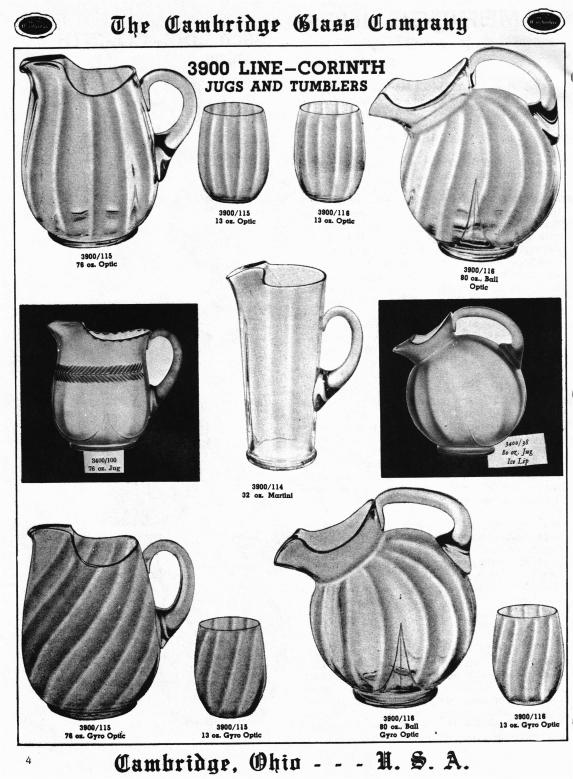Cambridge Jugs, Part V
by Mark Nye
Issue No. 141 - January 1985
Note: A number of the jugs discussed in this article appear on the Catalog page shown at the end of the article.
During the past few months Cambridge pitchers, shown in the 1940 catalog, were discussed. Our attention now turns to the catalogs and supplements issued by Cambridge between June 1949 and their final closing.
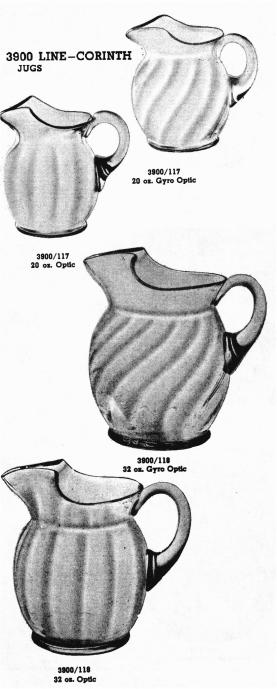 Several of the jugs offered during those years were previously
covered, but - within the pages of the 1949-53 catalog we find
five in the Corinth line, two in the Heirloom pattern (which
was a continuation of the Martha Washington line) and two from
the short lived milk glass line - none of which have yet been
discussed in this series of articles! No new jugs were designed and
produced during the reopen period but several jugs first produced in
earlier years continued to be a part of the Cambridge line until the
very end.
Several of the jugs offered during those years were previously
covered, but - within the pages of the 1949-53 catalog we find
five in the Corinth line, two in the Heirloom pattern (which
was a continuation of the Martha Washington line) and two from
the short lived milk glass line - none of which have yet been
discussed in this series of articles! No new jugs were designed and
produced during the reopen period but several jugs first produced in
earlier years continued to be a part of the Cambridge line until the
very end.
With one exception, the five jugs in the #3900 Corinth line are simply extensions or reworks of old Cambridge friends. The 20 oz. #3900/117 and the 32 oz. version of the same style, #3900/118, are similar in design to the Pristine #70 20 oz. jug (see December 1984 C.B., page 5 for a picture). The #3900/115 is an extension of the #3400/100 jug and the #3900/116 is an offspring of the grandfather of all ball jugs, the #3400/38 jug (see black inserts on the accompanying photo for examples of these earlier #3400 line jugs.) Apparently the only new jug in the Corinth line was the #3900/114 32 oz. martini which does not seem to come from an earlier pitcher or jug.
The Corinth jugs, #115, #116, #117 and #118 were made in crystal as well as moonlight, amber, amethyst, emerald and mandarin gold. While catalog pages show these jugs with two types of optic design, straight and gyro, the existing price lists make no differentiation and thus it is not clear if both types were made in all the colors - it can only be assumed that they were.
The #3900/114 martini is unique among the #3900 jugs in that it was not listed as being made in color. It was made non-optic as well as optic and according to available price lists, was not produced with the gyro optic pattern. Exactly when during the late 1940s the Corinth jugs were introduced was not determined, but the martini was available when the 1949 catalog was initially issued in June of that year.
The martini jug, like all of the #3900 jugs was produced in crystal, plain or etched Candlelight, Chantilly, Diane, Elaine, Portia, Wildflower and Rose Point. In addition to these etchings, the martini pitcher was also etched Vichy and Magnolia - the only Corinth jug to be decorated thusly.
Only three of the five Corinth jugs were decorated with rock crystal cuttings - the martini and the #115 and #117. The martini jug was listed in the September 1950 price list as being available with the King Edward cutting. The next available complete price list is dated October 1953 and it had the martini listed as being cut Harvest, King Edward, Rondo, Lattice, Swirl, Star and Fleur-de-Lis. During the reopen period, the #3900/114 martini was also cut Wedding Rings.
The origins of the #3900/115 jug extend back into the 1930s when an optic version of the #3400/100 jug was made. It, however, had no ice lip and hence the top was slightly different in shape. The #3900/115, in addition to the previously listed etchings was also included in the Roselyn line. This jug was extensively used for rock crystal cuttings. King Edward, Harvest, Rondo, Bexley, Laurel Wreath, Thistle, Lynbrook, Radiant Rose, Roxberry, Tempo and #1064 and #1065 will be found on this jug.
The #3900/115 jug made the transition into the reopen period with color production ceasing sometime in 1957. It remained available in crystal, plain or etched Chantilly, Rose Point, and Wildflower until the final closing. The last Cambridge price list issued in 1958 also had this jug available with many of the following cuttings; Harvest, King Edward, Laurel Wreath, Lynbrook, Radiant Rose, Rondo, Roxberry and Tempo.
The #3900/116 jug represents the final use of the ball shape design which was first introduced in 1930-31. Neither of the #3900/116 jugs, optic of gyro optic, are "new" in that they very closely resemble earlier jugs. An optic #3400/38 80 oz. ball jug was shown by Cambridge in 1933 and the original Gyro Optic line, including jugs, was introduced in 1938. The #3900/116 jugs do have openings that are larger than those found in their predecessor and at the same time, these larger openings vary slightly in shape. While not listed as being decorated with rock crystal cuttings, the #3900/116 jug was etched Candlelight, Chantilly, Diane, Elaine, Portia, Rose Point and Wildflower as well as Roselyn. With the exception of Candlelight and Portia, the #3900/116 jug was offered with these etchings in the October 1953 price list, the last listing for this jug.
The #3900/117 and #3900/118 jugs have almost identical histories
except that in addition to the etchings previously listed as being
found on all Corinth jugs, the #118 was also etched Roselyn which the
#117 was not. The #117 was cut King Edward with the #118 never listed
with a cutting. 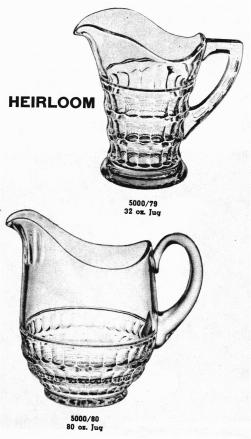 Both jugs continued to be offered during the early
years of the reopen period but do not appear after March of 1956. At
that time, they were available in crystal, plain or etched Chantilly,
Rose Point and Wildflower, and in amber, amethyst, emerald and mandarin
gold. The #117 was still available with the King Edward cutting.
Both jugs continued to be offered during the early
years of the reopen period but do not appear after March of 1956. At
that time, they were available in crystal, plain or etched Chantilly,
Rose Point and Wildflower, and in amber, amethyst, emerald and mandarin
gold. The #117 was still available with the King Edward cutting.
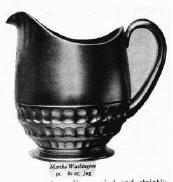 At first glance the Heirloom #5000/80 80 oz. jug (shown at right) appears to be the
same as the Martha Washington #30 80 oz. jug (left). While the basic shape
remained the same, they are not the same jug. The most readily
noticeable difference being the Heirloom jug does not have a foot. The
second Heirloom jug, the #5000/79 32 oz. takes the same shape as the
#41 cream. This shape was first used for the Martha Washington #1 cream
which in the Heirloom line was known as the #5000/44 footed cream.
At first glance the Heirloom #5000/80 80 oz. jug (shown at right) appears to be the
same as the Martha Washington #30 80 oz. jug (left). While the basic shape
remained the same, they are not the same jug. The most readily
noticeable difference being the Heirloom jug does not have a foot. The
second Heirloom jug, the #5000/79 32 oz. takes the same shape as the
#41 cream. This shape was first used for the Martha Washington #1 cream
which in the Heirloom line was known as the #5000/44 footed cream.
The Heirloom jugs, introduced in late 1952 or early 1953, were made in crystal during the relatively short production period. Short, since they were not a part of the Cambridge line during the reopen period.
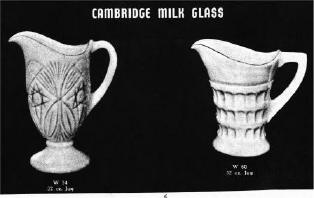 The #5000/79 jug was also made in milk glass and as such was known
simply as W60 32 oz. jug. One other milk glass item, the W54 32 oz. jug
brings us to the last of the Cambridge jugs. The W54 obviously was from
a mold dating to a much earlier period and strictly speaking was not a
new jug at the time. Either of the milk glass jugs would be a welcome
addition to a Cambridge pitcher collection since they are rarely
seen.
The #5000/79 jug was also made in milk glass and as such was known
simply as W60 32 oz. jug. One other milk glass item, the W54 32 oz. jug
brings us to the last of the Cambridge jugs. The W54 obviously was from
a mold dating to a much earlier period and strictly speaking was not a
new jug at the time. Either of the milk glass jugs would be a welcome
addition to a Cambridge pitcher collection since they are rarely
seen.
The five Corinth jugs expanded into all their colors, etching and cuttings, as well as optic patterns, give us a total of 111 different jugs. Add the Heirloom and milk glass jugs and we are off and running - looking for 115 Cambridge jugs to add to our collection! Happy Collecting.
